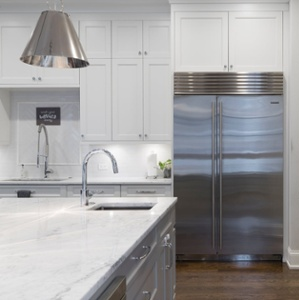Stone Quality & Pricing

Mineral Composition
The mineral composition of natural stone primarily consists of quartz, feldspar, and mica, but secondary mineral deposits can exist that make beautiful multi-colored stone with waves and veins that run through a block of stone, and ultimately the slab. Typically stone with waves and movement are considered exotic colors, which may have blue, purple, red, black, or green movements through a slab. These colors are rare in stone, and because of the limited supply of exotic colors, the prices are higher for multi-colored slabs of stone.
In general, stone that is very homogenous in color and has no movement or veining in the slab is much more abundant and thus less expensive. In short, the laws of supply and demand are the dominant reason for price differences in the color of natural stone, and though the stone colors that are of abundant supply are considered lower quality, they can also beautify a home.
Types of Stone
There are several different types of natural stone that are popular for countertops. Granite, marble, quartzite, and soapstone are the favored types of natural stone used by homeowners. Each of the above stone types has a different geological ingredient, hardness, and color, which can all contribute to differences in price.
The full spectrum of colors can be exhibited by granites, while marbles are typically white, grey, and black. However, marble can be more difficult to fabricate because of quartz veins, which may cause chipping and a longer fabrication process, so the price may be higher because of the extra labor and risk associated with the fabrication of marble.
Quartzite has become trendy because it possesses a lot of marble qualities, yet it is more durable and hard than marble, so its use has increased over the past few years. Soapstone is a dark soft stone that has been used for centuries; it is a soft stone that will not stain and is quite kitchen-friendly, but it will scratch. Soapstone is considered a high-quality stone that is very durable and when scratched can easily be repaired. Stone type has a minimal impact on the price of stone, though marble can oftentimes be the most expensive stone type, followed by quartzite, soapstone, and granite.
Grades of Stone
The grade of stone is an important variable in the price and quality of stone. There are three grades for natural stone: commercial, standard, and first choice. Commercial quality stone has a lot of defects in color and slab integrity. For example, a commercial-grade slab of St. Cecilia granite will likely have a basketball-sized dark spot on the slab, color variation throughout the slab, and small cracks or fissures through the slab. This grade of stone is used for apartment and hotel projects where the full slab is not needed, and only a portion is needed, and some of the imperfections in the slab can be avoided.
A consumer would typically not use this grade of stone in his or her house. Standard grade granite will have some small spots that appear inconsistent on the slab, but this grade of granite can be used in a home because often the discoloration can be avoided, especially if it is used for the perimeter of a kitchen. However, because of the minimal imperfections in color, a consumer would not want this grade of stone as an island because the defects would be noticeable.
Finally, the first-choice grade is the best and would be a clean slab with no fissures, cracks, or noticeable color variations. The first choice is more expensive because there are fewer of these pieces in a block of granite, and these slabs are of higher demand. In summary, the grade of granite is directly correlated to the price of the stone, and the quality (grade) is related to the price.
Origin of Stone
The origin of the natural stone is also a differentiating factor in the price and quality of stone. Brazil, Italy, India, and China are the dominant exporting countries of natural stone. Stone that originates from China is much less expensive than stone from any of the other areas because of the low cost of labor and the non-exotic colors produced. Italy has the most expensive marbles in the world because of their beauty and minimal supply. Brazil and India have an abundance of natural stone quarries and primarily export granites, and while both regions have very exotic material, none of them have the quality of marble and colors of Italy.
In conclusion, the price and quality of natural stone are dependent on color, type, grade, and origin of the stone. Most consumers could readily view the difference between St. Cecilia granite from Brazil and Carrara marble from Italy, and most would surmise that Carrara marble is of higher quality and price versus St. Cecilia granite. However, it is possible to have a good quality stone on a limited budget, and your stone fabricator can assist you in your search based on your use, need, and budget.
Schedule a Consultation

